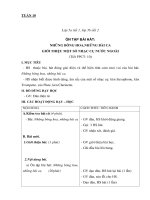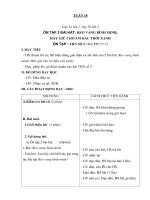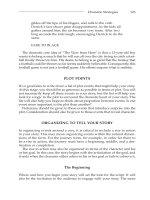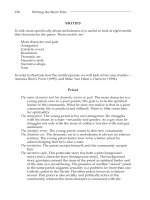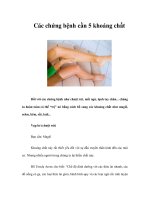Tài liệu DocBox the Definitive Guide-Chapter 5. Customizing DocBook docx
Bạn đang xem bản rút gọn của tài liệu. Xem và tải ngay bản đầy đủ của tài liệu tại đây (93.82 KB, 45 trang )
Chapter 5. Customizing DocBook
For the applications you have in mind, DocBook "out of the box" may not be
exactly what you need. Perhaps you need additional inline elements or
perhaps you want to remove elements that you never want your authors to
use. By design, DocBook makes this sort of customization easy.
This chapter explains how to make your own customization layer. You
might do this in order to:
• Add new elements
• Remove elements
• Change the structure of existing elements
• Add new attributes
• Remove attributes
• Broaden the range of values allowed in an attribute
• Narrow the range of values in an attribute to a specific list or a fixed
value
You can use customization layers to extend DocBook or subset it. Creating a
DTD that is a strict subset of DocBook means that all of your instances are
still completely valid DocBook instances, which may be important to your
tools and stylesheets, and to other people with whom you share documents.
An extension adds new structures, or changes the DTD in a way that is not
compatible with DocBook. Extensions can be very useful, but might have a
great impact on your environment.
Customization layers can be as small as restricting an attribute value or as
large as adding an entirely different hierarchy on top of the inline elements.
5.1. Should You Do This?
Changing a DTD can have a wide-ranging impact on the tools and
stylesheets that you use. It can have an impact on your authors and on your
legacy documents. This is especially true if you make an extension. If you
rely on your support staff to install and maintain your authoring and
publishing tools, check with them before you invest a lot of time modifying
the DTD. There may be additional issues that are outside your immediate
control. Proceed with caution.
That said, DocBook is designed to be easy to modify. This chapter assumes
that you are comfortable with SGML/XML DTD syntax, but the examples
presented should be a good springboard to learning the syntax if it's not
already familiar to you.
5.2. If You Change DocBook, It's Not DocBook Anymore!
The DocBook DTD is usually referenced by its public identifier:
-//OASIS//DTD DocBook V3.1//EN
Previous versions of DocBook, V3.0 and the V2 variants, used the owner
identifier Davenport, rather than OASIS.
If you make any changes to the structure of the DTD, it is imperative that
you alter the public identifier that you use for the DTD and the modules you
changed. The license agreement under which DocBook is distributed gives
you complete freedom to change, modify, reuse, and generally hack the
DTD in any way you want, except that you must not call your alterations
"DocBook."
You should change both the owner identifier and the description. The
original DocBook formal public identifiers use the following syntax:
-//OASIS//text-class DocBook description
Vversion//EN
Your own formal public identifiers should use the following syntax in order
to record their DocBook derivation:
-//your-owner-ID//text-class DocBook Vversion-Based
[Subset|Extension|Variant] your-descrip-and-
version//lang
For example:
-//O'Reilly//DTD DocBook V3.0-Based Subset V1.1//EN
If your DTD is a proper subset, you can advertise this status by using the
Subset keyword in the description. If your DTD contains any markup
model extensions, you can advertise this status by using the Extension
keyword. If you'd rather not characterize your variant specifically as a subset
or an extension, you can leave out this field entirely, or, if you prefer, use the
Variant keyword.
There is only one file that you may change without changing the public
identifier: dbgenent.mod. And you can add only entity and notation
declarations to that file. (You can add anything you want, naturally, but if
you add anything other than entity and notation declarations, you must
change the public identifier!)
5.3. Customization Layers
SGML and XML DTDs are really just collections of declarations. These
declarations are stored in one or more files. A complete DTD is formed by
combining these files together logically. Parameter entities are used for this
purpose. Consider the following fragment:
<!ENTITY % dbpool SYSTEM "dbpool.mod"> (1)
<!ENTITY % dbhier SYSTEM "dbhier.mod"> (2)
%dbpool; (3)
%dbhier; (4)
(1)
This line declares the parameter entity dbpool and associates it with
the file dbpool.mod.
(2)
This line declares the parameter entity dbhier and associates it with
the file dbhier.mod.
(3)
This line references dbpool, which loads the file dbpool.mod and
inserts its content here.
(4)
Similarly, this line loads dbhier.mod.
It is an important feature of DTD parsing that entity declarations can be
repeated. If an entity is declared more than once, then the first declaration is
used. Given this fragment:
<!ENTITY foo "Lenny">
<!ENTITY foo "Norm">
The replacement text for &foo; is "Lenny."
These two notions, that you can break a DTD into modules referenced with
parameter entities and that the first entity declaration is the one that counts,
are used to build "customization layers." With customization layers you can
write a DTD that references some or all of DocBook, but adds your own
modifications. Modifying the DTD this way means that you never have to
edit the DocBook modules directly, which is a tremendous boon to
maintaining your modules. When the next release of DocBook comes out,
you usually only have to make changes to your customization layer and your
modification will be back in sync with the new version.
Customization layers work particularly well in DocBook because the base
DTD makes extensive use of parameter entities that can be redefined.
5.4. Understanding DocBook Structure
DocBook is a large and, at first glance, fairly complex DTD. Much of the
apparent complexity is caused by the prolific use of parameter entities. This
was an intentional choice on the part of the maintainers, who traded "raw
readability" for customizability. This section provides a general overview of
the structure of the DTD. After you understand it, DocBook will probably
seem much less complicated.
5.4.1. DocBook Modules
DocBook is composed of seven primary modules. These modules
decompose the DTD into large, related chunks. Most modifications are
restricted to a single chunk.
Figure 5-1
shows the module structure of DocBook as a flowchart.
Figure 5-1. Structure of the DocBook DTD
The modules are:
docbook.dtd
The main driver file. This module declares and references the other
top-level modules.
dbhier.mod
The hierarchy. This module declares the elements that provide the
hierarchical structure of DocBook (sets, books, chapters, articles, and
so on).
Changes to this module alter the top-level structure of the DTD. If you
want to write a DocBook-derived DTD with a different structure
(something other than a book), but with the same paragraph and
inline-level elements, you make most of your changes in this module.
dbpool.mod
The information pool. This module declares the elements that describe
content (inline elements, bibliographic data, block quotes, sidebars,
and so on) but are not part of the large-scale hierarchy of a document.
You can incorporate these elements into an entirely different element
hierarchy.
The most common reason for changing this module is to add or
remove inline elements.
dbnotn.mod
The notation declarations. This module declares the notations used by
DocBook.
This module can be changed to add or remove notations.
dbcent.mod
The character entities. This module declares and references the ISO
entity sets used by DocBook.
Changes to this module can add or remove entity sets.
dbgenent.mod
The general entities. This is a place where you can customize the
general entities available in DocBook instances.
This is the place to add, for example, boiler plate text, logos for
institutional identity, or additional notations understood by your local
processing system.
cals-tbl.dtd
The CALS Table Model. CALS is an initiative by the United States
Department of Defense to standardize the document types used across
branches of the military. The CALS table model, published in MIL-
HDBK-28001, was for a long time the most widely supported SGML
table model (one might now argue that the HTML table model is more
widely supported by some definitions of "widely supported"). In any
event, it is the table model used by DocBook.
DocBook predates the publication of the OASIS Technical Resolution
TR 9503:1995, which defines an industry standard exchange table
model and thus incorporates the full CALS Table Model.
Most changes to the CALS table model can be accomplished by
modifying parameter entities in dbpool.mod; changing this DTD
fragment is strongly discouraged. If you want to use a different table
model, remove this one and add your own.
*.gml
The ISO standard character entity sets. These entity sets are not
actually part of the official DocBook distribution, but are referenced
by default.
There are some additional modules, initially undefined, that can be inserted
at several places for "redeclaration." This is described in more detail in
Section 5.8.5
."
5.4.2. DocBook Parameterization
Customization layers are possible because DocBook has been extensively
parameterized so that it is possible to make any changes that might be
desired without ever editing the actual distributed modules. The parameter
entities come in several flavors:
%*.class;
Classes group elements of a similar type: for example all the lists are
in the %list.class;
.
If you want to add a new kind of something (a new kind of list or a
new kind of verbatim environment, for example), you generally want
to add the name of the new element to the appropriate class.
%*.mix;
Mixtures are collections of classes that appear in content models. For
example, the content model of the Example
element includes
%example.mix;
. Not every element's content model is a single
mixture, but elements in the same class tend to have the same mixture
in their content model.
If you want to change the content model of some class of elements
(lists or admonitions, perhaps), you generally want to change the
definition of the appropriate mixture.
%*.module;
The %*.module; parameter entities control marked sections
around
individual elements and their attribute lists. For example, the element
and attribute declarations for Abbrev
occur within a marked section
delimited by %abbrev.module;
.
If you want to remove or redefine an element or its attribute list, you
generally want to change its module marked section to IGNORE and
possibly add a new definition for it in your customization layer.
%*.element;
The %*.element; parameter entities were introduced in DocBook
V3.1; they control marked sections around individual element
declarations.
%*.attlist;
The %*.attlist; parameter entities were introduced in DocBook
V3.1; they control marked sections around individual attribute list
declarations.
%*.inclusion;, %*.exclusion;
These parameter entities control the inclusion and exclusion markup
in element declarations.
Changing these declarations allows you to make global changes to the
inclusions and exclusions in the DTD.
%local.*;
The %local.*; parameter entities are a local extension mechanism.
You can add markup to most entity declarations simply by declaring
the appropriate local parameter entity.
5.5. The General Structure ofCustomization Layers
Although customization layers vary in complexity, most of them have the
same general structure as other customization layers of similar complexity.
In the most common case, you probably want to include the entire DTD, but
you want to make some small changes. These customization layers tend to
look like this:
(1) Overrides of Entity Declarations Here
(2) <!ENTITY % orig-docbook "-//OASIS//DTD DocBook
V3.1//EN">
%orig-docbook;
(3) New/Modified Element and Attribute Declarations
Here
(1)
Declare new values for parameter entities (%local.*;,
%*.element;, %*.attlist;) that you wish to modify.
(2)
Include the entire DocBook DTD by parameter entity reference.
(3)
Add new element and attribute declarations for any elements that you
added to the DTD.
In slightly more complex customization layers, the changes that you want to
make are influenced by the interactions between modules. In these cases,
rather than including the whole DTD at once, you include each of the
modules separately, perhaps with entity or element declarations between
them:
Overrides of Most Entity Declarations Here
<!ENTITY % orig-pool "-//OASIS//ELEMENTS DocBook
Information Pool V3.1//EN">
%orig-pool;
Overrides of Document Hierarchy Entities Here
<!ENTITY % orig-hier "-//OASIS//ELEMENTS DocBook
Document Hierarchy V3.1//EN">
%orig-hier;
New/Modified Element and Attribute Declarations
Here
<!ENTITY % orig-notn "-//OASIS//ENTITIES DocBook
Notations V3.1//EN">
%orig-notn;
<!ENTITY % orig-cent "-//OASIS//ENTITIES DocBook
Character Entities V3.1//EN">
%orig-cent;
<!ENTITY % orig-gen "-//OASIS//ENTITIES DocBook
Additional General Entities V3.1//EN">
%orig-gen;
Finally, it's worth noting that in the rare case in which you need certain
kinds of very simple, "one-off" customizations, you can do them in the
document subset:
<!DOCTYPE book PUBLIC "-//OASIS//DTD DocBook
V3.1//EN" [
Overrides of Entity Declarations Here
New/Modified Element and Attribute Declarations
Here
]>
<book> </book>
5.6. Writing, Testing, and Using a Customization Layer
The procedure for creating, testing, and using a customization layer is
always about the same. In this section, we'll go through the process in some
detail. The rest of the sections in this chapter describe a range of useful
customization layers.
5.6.1. Deciding What to Change
If you're considering writing a customization layer, there must be something
that you want to change. Perhaps you want to add an element or attribute,
remove one, or change some other aspect of the DTD.
Adding an element, particularly an inline element, is one possibility. If
you're writing documentation about an object-oriented system, you may
have noticed that DocBook provides ClassName
but not MethodName.
Suppose you want to add MethodName?
5.6.2. Deciding How to Change a Customization Layer
Figuring out what to change may be the hardest part of the process. The
organization of the parameter entities is quite logical, and, bearing in mind
the organization described in Section 5.4
," finding something similar usually
provides a good model for new changes.
One resource that may be useful is the alternate version of this book that
shows all of the element content models in terms of the parameter entities
which define them, rather than the "flattened" versions shown here. The
alternate version is on the CD-ROM and online at the book web site:
/>.
MethodName is similar to ClassName
, so ClassName is probably a
good model. ClassName
is an inline element, not a hierarchy element, so
it's in dbpool.mod. Searching for "classname" in dbpool.mod reveals:
<!ENTITY % local.tech.char.class "">
<!ENTITY % tech.char.class
"Action|Application|ClassName|Command|ComputerOutpu
t
|Database|Email|EnVar|ErrorCode|ErrorName|ErrorType
|Filename
|Function|GUIButton|GUIIcon|GUILabel|GUIMenu|GUIMen
uItem
|GUISubmenu|Hardware|Interface|InterfaceDefinition|
KeyCap
|KeyCode|KeyCombo|KeySym|Literal|Constant|Markup|Me
diaLabel
|MenuChoice|MouseButton|MsgText|Option|Optional|Par
ameter
|Prompt|Property|Replaceable|ReturnValue|SGMLTag|St
ructField
|StructName|Symbol|SystemItem|Token|Type|UserInput|
VarName
%local.tech.char.class;">
Searching further reveals the element and attribute declarations for
ClassName
.
It would seem (and, in fact, it is the case) that adding MethodName can be
accomplished by adding it to the local extension mechanism for
%tech.char.class;
, namely %local.tech.char.class;, and
adding element and attribute declarations for it. A customization layer that
does this can be seen in Example 5-1
.
Example 5-1. Adding MethodName with a Customization Layer
<!ENTITY % local.tech.char.class "|MethodName">
(1)
<! load DocBook >
(2)
<!ENTITY % DocBookDTD PUBLIC "-//OASIS//DTD DocBook
V3.1//EN">
%DocBookDTD;
<!ELEMENT MethodName - - ((%smallcptr.char.mix;)+)
(3)>
<!ATTLIST MethodName
(4)
%common.attrib;
%classname.role.attrib;
%local.classname.attrib;
>
(1)
Declare the appropriate parameter entity (these are described in
Section 5.4.2
"). The declaration in your customization layer is
encountered first, so it overrides the definition in the DocBook DTD
(all the local classes are defined as empty in the DTD).
(2)
Use a parameter entity to load the entire DocBook DTD.
(3)
Add an element declaration for the new element. The content model
for this element is taken directly from the content model of
ClassName
.
(4)
Add an attribute list declaration for the new element. These are the
same attributes as ClassName
.
5.6.3. Using Your Customization Layer
In order to use the new customization layer, you must save it in a file, for
example mydocbk.dtd, and then you must use the new DTD in your
document.
The simplest way to use the new DTD is to point to it with a system
identifier:
<!DOCTYPE chapter SYSTEM "/path/to/mydocbk.dtd">
<chapter><title>My Chapter</title>
<para>
The Java <classname>Math</classname> class provides
a
<methodname>abs</methodname> method to compute
absolute value of a number.
</para>
</chapter>
If you plan to use your customization layer in many documents, or exchange
it with interchange partners, consider giving your DTD its own public
identifier, as described in Section 5.2
"
In order to use the new public identifier, you must add it to your catalog:
PUBLIC "-//Your Organization//DTD DocBook V3.1-
Based Extension V1.0//EN"
"/share/sgml/mydocbk.dtd"
and use that public identifier in your documents:
<!DOCTYPE chapter
PUBLIC "-//Your Organization//DTD DocBook V3.1-
Based Extension V1.0//EN">
<chapter><title>My Chapter</title>
<para>
The Java <classname>Math</classname> class provides
a
<methodname>abs</methodname> method to compute
absolute value of a number.
</para>
</chapter>
If you're using XML, remember that you must provide a system identifier
that satisfies the requirements of a Uniform Resource Identifier (URI).
5.7. Testing Your Work
DTDs, by their nature, contain many complex, interrelated elements.
Whenever you make a change to the DTD, it's always wise to use a
validating parser to double-check your work. A parser like nsgmls from
James Clark's SP can identify elements (attributes, parameter entities) that
are declared but unused, as well as ones that are used but undeclared.
A comprehensive test can be accomplished with nsgmls using the -wall
option. Create a simple test document and run:
nsgmls (1)-sv (2)-wall test.sgm
(1)
The -s option tells nsgmls to suppress its normal output (it will still
show errors, if there are any). The -v option tells nsgmls to print its
version number; this ensures that you always get some output, even if
there are no errors.
(2)
The -wall option tells nsgmls to provide a comprehensive list of all
errors and warnings. You can use less verbose, and more specific
options instead; for example, -wundefined to flag undefined
elements or -wunused-param to warn you about unused parameter
entities. The nsgmls documentation provides a complete list of
warning types.
5.7.1. DocBook V3.1 Warnings
If you run the preceding command over DocBook V3.1, you'll discover one
warning generated by the DTD:
nsgmls:I: SP version "1.3"
nsgmls:cals-tbl.dtd:314:37:W: content model is
mixed but does not allow #PCDATA everywhere
This is not truly an error in the DTD, and can safely be ignored. The warning
is caused by "pernicious mixed content" in the content model of DocBook's
Entry
element. See the Entry reference page for a complete discussion.
5.8. Removing Elements
DocBook has a large number of elements. In some authoring environments,
it may be useful or necessary to remove some of these elements.
5.8.1. Removing MsgSet
MsgSet
is a favorite target. It has a complex internal structure designed for
describing interrelated error messages, especially on systems that may
exhibit messages from several different components. Many technical
documents can do without it, and removing it leaves one less complexity to
explain to your authors.
Example 5-2
shows a customization layer that removes the MsgSet element
from DocBook:
Example 5-2. Removing MsgSet
<!ENTITY % compound.class "Procedure|SideBar"> (1)
<!ENTITY % msgset.content.module "IGNORE"> (2)
<! load DocBook >
<!ENTITY % DocBookDTD PUBLIC "-//OASIS//DTD DocBook
V3.1//EN">
%DocBookDTD;
(1)
Remove MsgSet
from the %compound.class;. This is the only
place in the DTD where MsgSet
is referenced.
(2)
Exclude the definition of MsgSet and all of its subelements from the
DTD.
5.8.2. Removing Computer Inlines
DocBook contains a large number of computer inlines. The DocBook inlines
define a domain-specific vocabulary. If you're working in another domain,
many of them may be unnecessary. You can remove a bunch of them by
redefining the %tech.char.class;
parameter entity and then excluding
the declarations for the elements removed. The initial definition of
%tech.char.class;
is:
<!ENTITY % tech.char.class
"Action|Application|ClassName|Command|ComputerOutpu
t
|Database|Email|EnVar|ErrorCode|ErrorName|ErrorType
|Filename
|Function|GUIButton|GUIIcon|GUILabel|GUIMenu|GUIMen
uItem
|GUISubmenu|Hardware|Interface|InterfaceDefinition|
KeyCap
|KeyCode|KeyCombo|KeySym|Literal|Markup|MediaLabel|
MenuChoice
|MouseButton|MsgText|Option|Optional|Parameter|Prom
pt|Property
|Replaceable|ReturnValue|SGMLTag|StructField|Struct
Name
|Symbol|SystemItem|Token|Type|UserInput
%local.tech.char.class;">
When examining this list, it seems that you can delete all of the inlines
except, perhaps, Application
, Command, Email, Filename,
Literal
, Replaceable, Symbol, and SystemItem. The following
customization layer removes them.
Example 5-3. Removing Computer Inlines
<!ENTITY % tech.char.class
"Application|Command|Email|Filename|Literal
|Replaceable|Symbol|SystemItem">
<!ENTITY % action.module "IGNORE">
<!ENTITY % classname.module "IGNORE">
<!ENTITY % computeroutput.module "IGNORE">
<!ENTITY % database.module "IGNORE">
<!ENTITY % envar.module "IGNORE">
<!ENTITY % errorcode.module "IGNORE">
<!ENTITY % errorname.module "IGNORE">
<!ENTITY % errortype.module "IGNORE">
<! <!ENTITY % function.module "IGNORE"> >
<!ENTITY % guibutton.module "IGNORE">
<!ENTITY % guiicon.module "IGNORE">
<!ENTITY % guilabel.module "IGNORE">
<!ENTITY % guimenu.module "IGNORE">
<!ENTITY % guimenuitem.module "IGNORE">
<!ENTITY % guisubmenu.module "IGNORE">
<!ENTITY % hardware.module "IGNORE">
<!ENTITY % interface.module "IGNORE">
<!ENTITY % interfacedefinition.module "IGNORE">
<! <!ENTITY % keycap.module "IGNORE"> >
<!ENTITY % keycode.module "IGNORE">
<! <!ENTITY % keycombo.module "IGNORE"> >
<! <!ENTITY % keysym.module "IGNORE"> >
<!ENTITY % markup.module "IGNORE">
<!ENTITY % medialabel.module "IGNORE">
<!ENTITY % menuchoice.module "IGNORE">
<! <!ENTITY % mousebutton.module "IGNORE"> >
<! <!ENTITY % msgtext.module "IGNORE"> >
<! <!ENTITY % option.module "IGNORE"> >
<! <!ENTITY % optional.module "IGNORE"> >
<! <!ENTITY % parameter.module "IGNORE"> >
<!ENTITY % prompt.module "IGNORE">
<!ENTITY % property.module "IGNORE">
<!ENTITY % returnvalue.module "IGNORE">
<!ENTITY % sgmltag.module "IGNORE">
<!ENTITY % structfield.module "IGNORE">
<!ENTITY % structname.module "IGNORE">
<!ENTITY % token.module "IGNORE">
<!ENTITY % type.module "IGNORE">
<!ENTITY % userinput.module "IGNORE">
<! load DocBook >
<!ENTITY % DocBookDTD PUBLIC "-//OASIS//DTD DocBook
V3.1//EN">
%DocBookDTD;
Initially we removed several more elements from %tech.char.class;
(%function.module;
, %keycap.module;), but using the testing
procedure described in Section 5.7
," we discovered that these elements are
used in other content models. Because they are used in other content
modules, they cannot simply be removed from the DTD by deleting them
from %tech.char.class;
. Even though they can't be deleted outright,
we've taken them out of most inline contexts.
It's likely that a customization layer that removed this many technical inlines
would also remove some larger technical structures (MsgSet
,
FuncSynopsis
), which allows you to remove additional elements from
the DTD.
5.8.3. Removing Synopsis Elements
Another possibility is removing the complex Synopsis elements. The
customization layer in Example 5-4
removes CmdSynopsis and
FuncSynopsis
.
Example 5-4. Removing CmdSynopsis and FuncSynopsis
<!ENTITY % synop.class "Synopsis">
<! Instead of "Synopsis|CmdSynopsis|FuncSynopsis
%local.synop.class;" >
<!ENTITY % funcsynopsis.content.module "IGNORE">
<!ENTITY % cmdsynsynopsis.content.module "IGNORE">
<! load DocBook >



